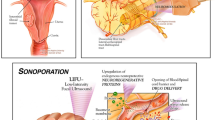Abstract
Numerous improvements in the understanding of the biology of primary brain tumors have been reported. The resultant application of this information to the therapy of these lesions offers promising alternatives. For any of a number of reasons delivery of these therapies to the target neoplasm can be challenging. Convection enhanced delivery has been established as a modality that has been shown to circumvent some of the impediments to treatment agent delivery. This report described the preliminary preclinical use of a balloon tipped catheter with a channel built in for infusion of therapy directly into the brain. A series of 10 canines were studied using bolus and continuous infusions with the balloon either inflated or deflated. The infusates contained gadolinium to allow imaging of the convection process. The character of the cerebral penetration is described ranging from minimal cerebral penetration with uninflated balloons used with bolus injections to extensive bilateral penetration using inflated balloons and continuous infusions. This data demonstrates the feasibility and potential value of such a system and warrants a more detailed analysis of the device using a wider variety of infusion parameters, assessment of larger infusate molecule sizes likely to be solely dependent on convection and direct comparison to standard catheter convection techniques.






Similar content being viewed by others
References
Uhm JH, Dooley NP, Villemure JG et al (1997) Mechanisms of glioma invasion: role of matrix-metalloproteinases. Can J Neurol Sci 24:3–15
Preusser M, Haberler C et al (2006) Malignant glioma: neuropathology and neurobiology. Wien Med Wochenschr 156:332–337
Mawrin C (2005) Molecular genetic alterations in gliomatosis cerebri: what can we learn about the origin and course of the disease? Acta Neuropathol 110:527–536
Pardridge WM (1998) CNS drug design based on principles of blood-brain barrier transport. J Neurochem 70:1781–1792
Engelhard HH (1998) Antisense oligodeoxynucleotide technology: potential use for the treatment of malignant brain tumors. Cancer Control 5:163–170
Groothuis DR (2000) The blood-brain and blood-tumor barriers: a review of strategies for increasing drug delivery. Neuro-Oncology 2:45–59
Bouvier G, Penn RD et al (1987) Direct delivery of medication into a brain tumor through multiple chronically implanted catheters. Neurosurgery 20:286–291
Walter KA, Tamargo RJ et al (1995) Intratumoral chemotherapy. Neurosurgery 37:1129–1145
Newton HB (2006) Advances in strategies to improve drug delivery to brain tumors. Expert Rev Neurother 6:1495–1509
Bobo R, Laske D et al (1994) Convection-enhanced delivery of macromolecules in the brain. Proc Natl Acad Sci USA 91:2076–2080
Morrison PF, Chen MY et al (1999) Focal delivery during direct infusion to brain: role of flow rate, catheter diameter, and tissue mechanics. Am J Physiol 277:R1218–R1229
Chen MY, Lonser RR et al (1999) Variables affecting convection-enhanced delivery to the striatum: a systematic examination of rate of infusion, cannula size, infusate concentration, and tissue-cannula sealing time. J Neurosurg 90:315–320
Raghavan R, Brady ML et al (2006) Convection-enhanced delivery of therapeutics for brain disease, and its optimization: neurosurgical focus. 20:E12. http://www.aans.org/education/journal/neurosurgical/Apr06/20-4-nsf-toc.asp
Lopez KA, Waziri AE et al (2006) Convection-enhanced delivery in the treatment of malignant glioma. Neurol Res 28(5):542–548
Lieberman D, Laske K et al (1995) Convection-enhanced distribution of large molecules in gray matter during interstitial drug infusion. J Neurosurg 82:1021–1029
Laske DW, Morrison PF et al (1997) Chronic interstitial infusion of protein to primate brain: determination of drug distribution and clearance with single-photon emission computerized tomography imaging. J Neurosurg 87:586–594
Laske DW, Youle RJ, Oldfield EH (1997) Tumor regression with regional distribution of the targeted toxin TF-CRM107 in patients with malignant brain tumors. Nat Med 3:1362–1368
Tatter SB, Shaw EG et al (2003) An inflatable balloon catheter and liquid 125I radiation source (GliaSite Radiation Therapy System) for treatment of recurrent glioma: multicenter and feasibility study. J Neurosurg 99:297–303
Stubbs JB, Strickland AD et al (2000) Biodistribution and dosimetry of an aqueous solution containing sodium 3-(125I) iodo-4-hydroxybenzenesulfonate (Iotrex) for brachytherapy of resected malignant brain tumors. Cancer Biother Radiopharm 15:645–656
Gabayan AJ, Green SB et al (2006) GliaSite brachytherapy for treatment of recurrent malignant gliomas: a retrospective multi-institutional analysis. Neurosurgery 58:701–709
Stubbs JB, Frankel RH et al (2002) Preclinical evaluation of a novel device for delivering brachytherapy to the margins of resected brain tumor cavities. J Neurosurg 9:335–343
Garfield J, Dayan AD et al (1975) Postoperative intracavitary chemotherapy of malignant supratentorial astrocytomas using BCNU. Clin Oncol 1:213–222
Acknowledgement
This work was supported in part by an unrestricted educational grant provided by Cytyc Corporation, Marlborough, MA, USA.
Author information
Authors and Affiliations
Corresponding author
Rights and permissions
About this article
Cite this article
Olson, J.J., Zhang, Z., Dillehay, D. et al. Assessment of a balloon-tipped catheter modified for intracerebral convection-enhanced delivery. J Neurooncol 89, 159–168 (2008). https://doi.org/10.1007/s11060-008-9612-7
Received:
Accepted:
Published:
Issue Date:
DOI: https://doi.org/10.1007/s11060-008-9612-7




